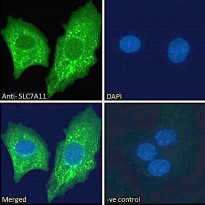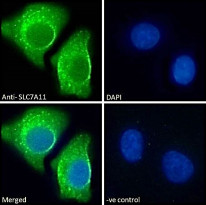ARG64200
anti-SLC7A11 / xCT antibody
anti-SLC7A11 / xCT antibody for ICC/IF and Human
Ferroptosis/Oxytosis Study antibody
Overview
| Product Description | Goat Polyclonal antibody recognizes SLC7A11 / xCT |
|---|---|
| Tested Reactivity | Hu |
| Tested Application | ICC/IF |
| Host | Goat |
| Clonality | Polyclonal |
| Isotype | IgG |
| Target Name | SLC7A11 / xCT |
| Antigen Species | Human |
| Immunogen | C-KGQTQNFKDAFSGRD |
| Conjugation | Un-conjugated |
| Alternate Names | xCT; CCBR1; Cystine/glutamate transporter; Solute carrier family 7 member 11; Amino acid transport system xc-; Calcium channel blocker resistance protein CCBR1 |
Application Instructions
| Application Suggestion |
|
||||
|---|---|---|---|---|---|
| Application Note | * The dilutions indicate recommended starting dilutions and the optimal dilutions or concentrations should be determined by the scientist. |
Properties
| Form | Liquid |
|---|---|
| Purification | Purified from goat serum by antigen affinity chromatography. |
| Buffer | Tris saline (pH 7.3), 0.02% Sodium azide and 0.5% BSA. |
| Preservative | 0.02% Sodium azide |
| Stabilizer | 0.5% BSA |
| Concentration | 0.5 mg/ml |
| Storage Instruction | For continuous use, store undiluted antibody at 2-8°C for up to a week. For long-term storage, aliquot and store at -20°C or below. Storage in frost free freezers is not recommended. Avoid repeated freeze/thaw cycles. Suggest spin the vial prior to opening. The antibody solution should be gently mixed before use. |
| Note | For laboratory research only, not for drug, diagnostic or other use. |
Bioinformation
| Database Links | |
|---|---|
| Background | This gene encodes a member of a heteromeric, sodium-independent, anionic amino acid transport system that is highly specific for cysteine and glutamate. In this system, designated Xc(-), the anionic form of cysteine is transported in exchange for glutamate. This protein has been identified as the predominant mediator of Kaposi sarcoma-associated herpesvirus fusion and entry permissiveness into cells. Also, increased expression of this gene in primary gliomas (compared to normal brain tissue) was associated with increased glutamate secretion via the XCT channels, resulting in neuronal cell death. [provided by RefSeq, Sep 2011] |
| Highlight | Related products: SLC7A11 antibodies; SLC7A11 Duos / Panels; Anti-Goat IgG secondary antibodies; Related news: Ferroptosis/Oxytosis Antibody Panel is launched Therapeutic strategies against PDAC |
| Research Area | Ferroptosis/Oxytosis Study antibody |
| Calculated MW | 55 kDa |
Images (2) Click the Picture to Zoom In
-
ARG64200 anti-SLC7A11 / xCT antibody ICC/IF image
Immunofluorescence: Paraformaldehyde-fixed HepG2 cells permeabilized with 0.15% Triton. Cells were stained with ARG64200 anti-SLC7A11 / xCT antibody (green) at 10 µg/ml dilution for 1 hour. DAPI (blue) for nuclear staining. Negative control: Unimmunized goat IgG (green) at 10 µg/ml dilution.
-
ARG64200 anti-SLC7A11 / xCT antibody ICC/IF image
Immunofluorescence: Paraformaldehyde-fixed A549 cells permeabilized with 0.15% Triton. Cells were stained with ARG64200 anti-SLC7A11 / xCT antibody (green) at 10 µg/ml dilution for 1 hour. DAPI (blue) for nuclear staining. Negative control: Unimmunized goat IgG (green) at 10 µg/ml dilution.







